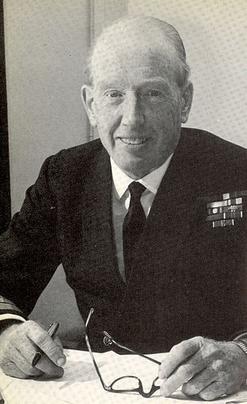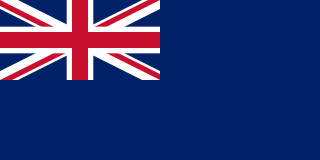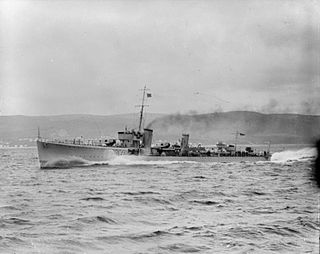
Aden is a port city located in Yemen in the southern part of the Arabian peninsula, positioned near the eastern approach to the Red Sea. It is situated approximately 170 km east of the Bab-el-Mandeb strait and north of the Gulf of Aden. With its strategic location on the coastline, Aden serves as a gateway between the Red Sea and the Arabian Sea, making it a crucial maritime hub connecting Africa, Asia, and the Middle East. As of 2023, Aden City has a population of approximately 1,080,000 residents, making it one of the largest cities in Yemen.

The Women's Royal Naval Service was the women's branch of the United Kingdom's Royal Navy. First formed in 1917 for the First World War, it was disbanded in 1919, then revived in 1939 at the beginning of the Second World War, remaining active until integrated into the Royal Navy in 1993. WRNS included cooks, clerks, wireless telegraphists, radar plotters, weapons analysts, range assessors, electricians and air mechanics.

The Far East Fleet was a fleet of the Royal Navy which existed between 1952 and 1971.

Admiral of the Fleet Sir Michael Le Fanu was a Royal Navy officer. He fought in the Second World War as gunnery officer in a cruiser operating in the Home Fleet during the Norwegian campaign and the Battle of the Mediterranean and then as gunnery officer in a battleship operating in the Eastern Fleet before becoming liaison officer between the British Pacific Fleet and the United States Third Fleet. After the War he commanded a frigate, a training establishment and an aircraft carrier. He served as First Sea Lord and Chief of the Naval Staff in the late 1960s. In that role, in the face of economic difficulties, he worked hard to reshape the Navy as an anti-submarine force operating primarily in the Atlantic Ocean.

The Battle of Madagascar was a Allied campaign to capture the Vichy French-controlled island Madagascar during World War II. The seizure of the island by the British was to deny Madagascar's ports to the Imperial Japanese Navy and to prevent the loss or impairment of the Allied shipping routes to India, Australia and Southeast Asia. It began with Operation Ironclad, the seizure of the port of Diego-Suarez near the northern tip of the island, on 5 May 1942.
Captain Stephen Wentworth Roskill, was a senior career officer of the Royal Navy, serving during the Second World War and, after his enforced medical retirement, served as the official historian of the Royal Navy from 1949 to 1960. He is now chiefly remembered as a prodigious author of books on British maritime history.
British Forces Aden was the name given to the British Armed Forces stationed in the Aden Protectorate during part of the 20th century. Their purpose was to preserve the security of the Protectorate from both internal threats and external aggression.

The Eastern Fleet, later called the East Indies Fleet, was a fleet of the Royal Navy which existed between 1941 and 1952.

SMS Emden was the second and final member of the Dresden class of light cruisers built for the German Kaiserliche Marine. Named for the town of Emden, she was laid down at the Kaiserliche Werft in Danzig in 1906. The hull was launched in May 1908, and completed in July 1909. She had one sister ship, Dresden. Like the preceding Königsberg-class cruisers, Emden was armed with ten 10.5 cm (4.1 in) guns and two torpedo tubes.

The Attack on Convoy BN 7 was a naval engagement in the Red Sea during the Second World War between a British force defending convoyed merchant ships and a flotilla of Italian destroyers. The Italian attack failed, with only one merchant ship being slightly damaged. After a chase, the British destroyer HMS Kimberley torpedoed the Italian destroyer Francesco Nullo which was beached on Harmil Island. Kimberley was hit, disabled by Italian shore batteries on the island and towed to safety by the cruiser HMS Leander.

HMS Grimsby was a sloop of the British Royal Navy, the lead ship of her class. Grimsby was built in the 1930s, entering service in 1934. Serving most of her pre-war service at Hong Kong, Grimsby was deployed on convoy escort duties along the East coast of the Britain and in the Mediterranean Sea during the Second World War, and was sunk by dive bombers off Tobruk on 25 May 1941.

The Commander-in-Chief, Levant was a senior administrative shore commander of the Royal Navy. The post was established in February 1943 when the British Chiefs of Staff Committee ordered the Mediterranean Fleet to be divided into two commands. One was responsible for naval operations involving ships, and the other, administrative and support, was responsible for shore establishments. His subordinate establishments and staff were sometimes informally known as the Levant Command or Levant Station. In December 1943 the title was changed to Flag Officer, Levant and East Mediterranean. In January 1944 the two separate commands were re-unified into a single command merging back into Commander-in-Chief Mediterranean Fleet.
The Flag Officer, Middle East was a command appointment of the Royal Navy, established for two distinct periods from 1946–58 and then from c. 1962–1967. From c. 1946–1958 the appointment was located in the Suez Canal Zone or, after the Suez Crisis, in the Cyprus area; when reestablished from the post of Flag Officer, Arabian Seas and Persian Gulf, the focus was on the other side of Arabia. The headquarters moved from HMS Juffair in Bahrain to HMS Sheba, Steamer Point, Aden in 1962, and was located there until the British evacuation from Aden in 1967.

During the First World War, the Commander-in-Chief at the Cape, Rear Admiral Herbert King-Hall, expended much effort to destroy the elusive German light cruiser Königsberg.

The Red Sea Station was a military formation of the Royal Navy. At various times it has also been referred to as Egypt Division and Red Sea and later the Red Sea and Canal Area. The Royal Navy had distinct formations for the Red Sea at intervals from 1846 until circa 1944-45.

The Naval Officer-in-Charge, Aden, was an administrative appointment of British Royal Navy originally established in 1839 as the Senior Naval Officer, Aden. He was responsible for HMS Sheba. It was a sub-command of the Flag Officer, Middle East.
In the Royal Navy, a Divisional Transport Officer (DTO) or a Divisional Naval Transport Officer (DNTO) and later called a Divisional Sea Transport Officer (DSTO) is a shore-based naval officer responsible for the efficient working of the transports and boats of the flotilla, division or squadron under his charge.

The British Baltic Fleet and also known as the Baltic Squadron was a series of temporary or semi permanent fleets of the Royal Navy. They were assembled at Spithead a naval anchorage in the English Channel for various naval operations in the Baltic Sea from 1658 to 1856 commanded by the Commander-in-Chief, Baltic Fleet.

Redcar Aerodrome is a former First World War airfield located in Redcar, North Yorkshire, England. The site hosted an elementary flying school for newly entered pilots into the Royal Naval Air Service, though some offensive and defensive operations were flown from Redcar as well. The base was created as part of chain of new air stations after the German naval bombardment of east coast towns in December 1914. The base had a brief operational lifespan between July 1915 and December 1919, after which it was decided not to retain Redcar as an active station, and much of the site has been re-used for housing.

HMS Stronghold was an S-class destroyer, which served with the Royal Navy during the Second World War. The ship was one of the first vehicles to deploy an unmanned aircraft. Launched on 6 May 1919, the destroyer was fitted with a simple catapult in 1924, which used a bag of sand as a weight, and launched the RAE 1921 Target, an early form of unmanned aircraft. A more sophisticated cordite catapult was fitted in 1927 and used to launch the more advanced RAE Larynx. In total, more than twenty test flights were undertaken before the catapult was removed. The destroyer was subsequently fitted out as a minelayer. At the start of the Second World War, the destroyer was based in Singapore. Stronghold helped to rescue the Supermarine Walrus from the battlecruiser Repulse, which had been sunk by the Japanese, in 1941 and, the following year, towed the destroyer Vendetta on the first part of the Royal Australian Navy vessel's journey to Fremantle. On 2 March 1942, the vessel was spotted by a Japanese reconnaissance seaplane and attacked by the heavy cruiser Maya, along with the two escorting destroyers Arashi and Nowaki. Heavily outgunned, the destroyer was sunk with the loss of nine officers and sixty-one ratings.













